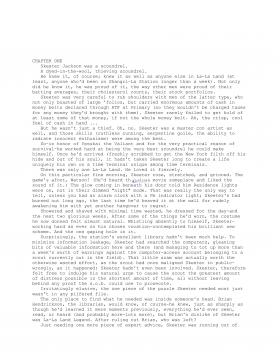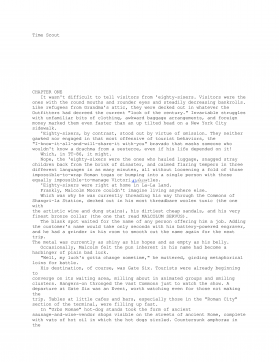fog would not trouble the underground world. Even temperature variations are limited to the open surface and would
not exist underground. Whether day or night, summer or winter, temperatures in the underground city would remain
equable and nearly constant. In place of spending energy on heating and cooling, you would have to spend energy on
ventilation, to be sure, but I think that this would involve a large net saving. Electrified transportation would be
required to avoid the pollution of the internal-combustion engine, but then walking (considering the certainty of good
weather) would become much more attractive and that, too, would not only save energy, but would promote better
health.
The only adverse environmental conditions that would affect the underground world would be volcanoes,
earthquakes, and meteoric impacts. However, we know where volcanoes exist and where earthquakes are common
and might avoid those areas. And perhaps we will have a space patrol to destroy any meteoric objects likely to bring
them uncomfortably close.
Second, local time would no longer be important. On the surface, the tyranny of day and night cannot be avoided,
and when it is morning in one place, it is noon in another, evening in still another and midnight in yet another. The
rhythm of human life is therefore out of phase. Underground, where artificial light will determine the day, we can if
we wish make a uniform time the planet over. This would certainly simplify global cooperation and would eliminate
jet lag. (If a global day and global night turn out to have serious deficiencies, any other system can be set up. The
point is it will be our system and not one forced on us by the accident of Earth’s rotation.)
Third, the ecological structure could be stabilized. Right now, with humanity on the planetary surface, we encumber
the Earth. Our enormous numbers take up room, as do all the structures we build to house ourselves and our
machines, to make possible our transportation and communication, to offer ourselves rest and recreation. All these
things distort the wild, depriving many species of plants and animals of their natural habitat—and sometimes,
involuntarily, favoring a few, such as rats and roaches.
If humanity and its structures are removed below ground —well below the level of the natural world of the
burrowing animals—Man would still occupy the surface with his farms, his forestry, his observation towers, his air
terminals and so on, but the extent of that occupation would be enormously decreased. Indeed, as one imagines the
underground world becoming increasingly elaborate, one can visualize much of the food supply eventually deriving
from soilless crops grown in artificially illuminated areas underground. The Earth’s surface might be increasingly
turned over to park and to wilderness, maintained at ecological stability.
Nor would we be depriving ourselves of nature. Indeed, it would be closer. It might seem that to withdraw
underground is to withdraw from the natural world, but would that be so? Would the withdrawal be more complete
than it is now, when so many people work in city buildings that are often windowless and artificially conditioned?
Even where there are windows, what is the prospect one views (if one bothers to), but sun, sky, and buildings to the
horizon—plus some limited greenery?
And to get away from the city now? To reach the real countryside? One must travel horizontally for miles and miles,
first across city pavements and then across suburban sprawls. And the countryside we would be viewing would be
steadily retreating and steadily undergoing damage.
In the underground world, we might have areas of greenery, too, even parks—and tropical growth in greenhouses.
But we don’t have to depend on these makeshift attempts, comforting though they may be to many. We need only go
straight up, a mere couple of hundred yards above the level of “Main Street, Underground” and—there you are.
The surface you would visit would be nature—perhaps tamer than it might be, but relatively unspoiled. The surface
would have to be protected from too frequent, or too intense, or too careless visiting, but however carefully restricted
the upward trips might be the chances are that the dwellers in the underground world would see more of the natural
world, under ecologically sounder conditions, than dwellers of surface cities do today.
I am interested to see, by the way, that the notion of underground living has begun to seem more realistic in the
decades since I wrote The Caves of Steel. For instance, many cities in the more northerly latitudes (where cold
weather, ice, and snow inhibit shopping by making it unpleasant) are building underground shopping malls—more
and more elaborate, more and more self-contained, more and more like my own imagined world.
However, my imagination is not the only one the world possesses. Here we have Refuge, by Rob Chilson, in which
file:///E|/Documents%20and%20Settings/Princess%20...20Robot%20City%20Book%205%20-%20Rob%20Chilson.htm (3 of 80)11/19/2005 3:53:34 AM

 2024-12-08 12
2024-12-08 12
 2024-12-08 14
2024-12-08 14
 2024-12-08 10
2024-12-08 10
 2024-12-08 10
2024-12-08 10
 2024-12-08 15
2024-12-08 15
 2024-12-08 18
2024-12-08 18
 2024-12-08 27
2024-12-08 27
 2024-12-08 25
2024-12-08 25
 2024-12-08 16
2024-12-08 16
 2024-12-08 30
2024-12-08 30








 渝公网安备50010702506394
渝公网安备50010702506394
